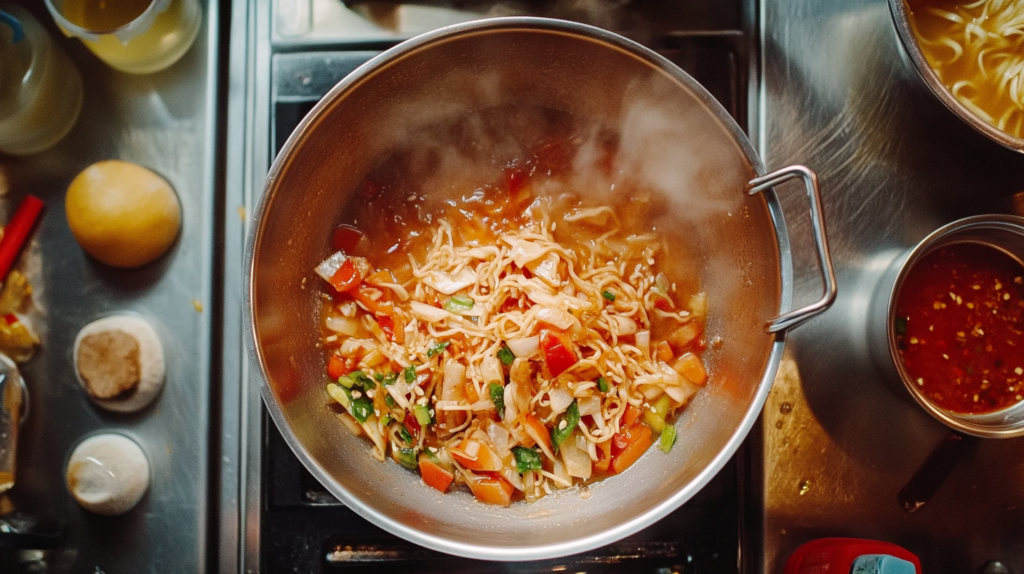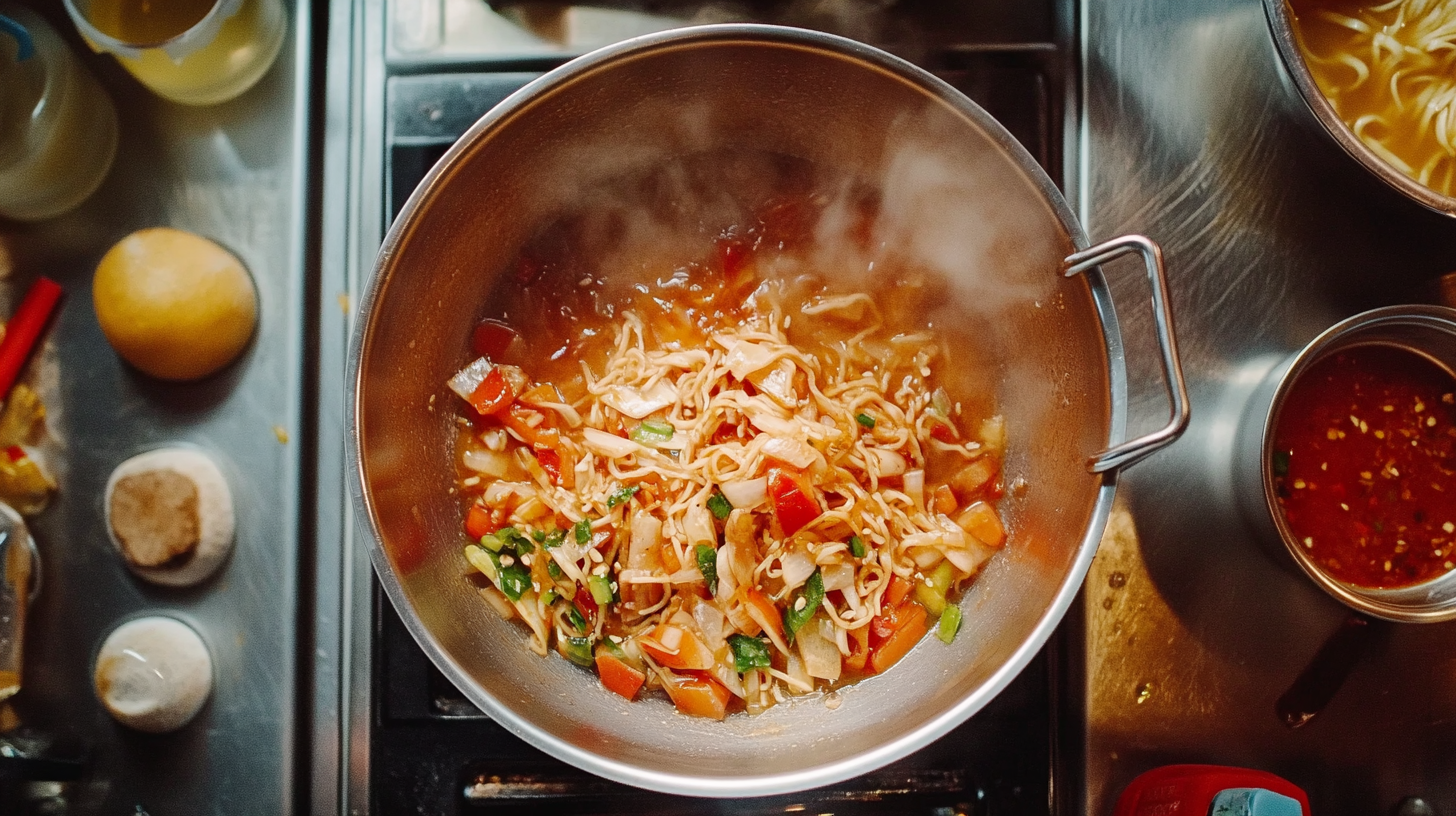Discover the essential ingredients and techniques that make drunken noodles sauce irresistibly flavorful and authentic.
Introduction
Drunken noodles, a beloved Thai dish, owe their rich flavor to a carefully crafted sauce. But what is drunken noodles sauce made of? Understanding its key ingredients and how they come together is essential to recreating this culinary delight at home. This comprehensive guide explores the essential components and techniques to perfect your own drunken noodles sauce.

Table of Contents
- Understanding Drunken Noodles
- Essential Ingredients of Drunken Noodles Sauce
- Additional Flavor Enhancers
- Step-by-Step Preparation of Drunken Noodles Sauce
- Tips for Authentic Flavor
- Common Mistakes to Avoid
- Frequently Asked Questions
- Conclusion
- Image Optimization Recommendations
- Post-Article Suggestions
Understanding Drunken Noodles
Drunken noodles, or Pad Kee Mao, is a spicy stir-fried noodle dish originating from Thailand. Contrary to its name, it isn’t specifically associated with alcohol but is believed to be a popular late-night dish enjoyed after drinking. The dish is characterized by its bold flavors and the use of a versatile sauce that binds all ingredients together.
In the upcoming section, we will explore what is drunken noodles sauce made of, breaking down each ingredient’s role in creating the dish’s signature taste.
Essential Ingredients of Drunken Noodles Sauce
Creating an authentic drunken noodles sauce involves a balance of savory, sweet, spicy, and tangy flavors. Below are the core components:
Soy Sauce
Soy sauce serves as the foundational umami element in the sauce. It provides depth and saltiness, essential for balancing other flavors.
- Light Soy Sauce: Adds a salty and savory taste without darkening the color significantly.
- Dark Soy Sauce: Offers a richer flavor and enhances the sauce’s color.
Using both types of soy sauce ensures a complex flavor profile that is both robust and balanced.
Oyster Sauce
Oyster sauce contributes a sweet and briny flavor, enriching the overall taste profile. It also adds a glossy finish to the noodles. The natural sweetness of oyster sauce complements the savory elements, creating a harmonious blend that enhances the dish’s depth.
Fish Sauce
Fish sauce is a staple in Thai cuisine, imparting a distinct salty and savory flavor. It enhances the umami depth of the sauce. Despite its strong aroma, fish sauce integrates seamlessly into the sauce, providing a necessary complexity that cannot be achieved with soy sauce alone.
Dark Soy Sauce
Dark soy sauce intensifies the color and adds a slightly sweeter, more robust flavor compared to light soy sauce. Its molasses-like consistency helps in thickening the sauce, ensuring that it clings well to the noodles and other ingredients.
Sweet Soy Sauce (Kecap Manis)
Although more common in Indonesian cuisine, sweet soy sauce can be used to introduce a hint of sweetness and complexity to the sauce. It balances the saltiness and spiciness, creating a well-rounded flavor profile. If unavailable, a combination of regular soy sauce and a touch of sugar can serve as a substitute.
Chili Paste
Chili paste provides the signature heat of drunken noodles. Adjust the quantity based on your spice tolerance to achieve the desired level of spiciness. Common chili pastes used include Sambal Oelek or Thai chili paste, which add both heat and a subtle depth of flavor.
Garlic and Onion
Fresh garlic and onions are sautéed to build the aromatic base of the sauce, infusing it with rich flavors. The caramelization of these aromatics during cooking adds a subtle sweetness and complexity, enhancing the overall taste of the dish.
Sugar
A touch of sugar balances the saltiness and acidity, ensuring the sauce isn’t overly intense. It rounds out the flavors, making the sauce more palatable and harmonious. Brown sugar or palm sugar can be used for a more authentic taste, adding a slight molasses flavor.
Vinegar or Lime Juice
Acidity from vinegar or lime juice brightens the sauce, adding a tangy contrast to the sweetness and umami. Lime juice, in particular, adds a fresh and vibrant note that elevates the dish, making it more lively and dynamic.
Additional Flavor Enhancers
To elevate the sauce further, consider incorporating the following ingredients:
Thai Basil
Thai basil adds a unique, peppery flavor with hints of anise, enhancing the dish’s authenticity. Its aromatic leaves release essential oils when stirred into the hot sauce, infusing the entire dish with their distinctive fragrance.
Vegetables and Protein
While not part of the sauce itself, the choice of vegetables and proteins can complement the sauce, absorbing its flavors and adding texture to the dish. Common additions include bell peppers, onions, carrots, and proteins like chicken, beef, shrimp, or tofu. These ingredients not only provide nutritional value but also contribute to the overall balance of flavors and textures in the dish.
For more detailed recipes and ingredient alternatives, visit Serious Eats or Bon Appétit.
Step-by-Step Preparation of Drunken Noodles Sauce
Creating the perfect drunken noodles sauce involves careful preparation and precise cooking techniques.
Preparing the Ingredients
- Gather Fresh Ingredients: Ensure all components, including garlic, onions, and Thai basil, are fresh for optimal flavor.
- Measure Accurately: Use precise measurements for sauces and spices to maintain the balance of flavors. This prevents the sauce from becoming too salty, sweet, or spicy.
- Prepare the Aromatics: Mince the garlic and slice the onions thinly. Properly preparing these ingredients ensures even distribution of flavor throughout the dish.
Cooking the Sauce
- Sauté Aromatics: Begin by heating oil in a wok or large skillet over medium-high heat. Add the minced garlic and sliced onions, sautéing until they become fragrant and slightly translucent. This step is crucial for building a flavorful base.
- Add Sauces: Incorporate soy sauce, oyster sauce, fish sauce, and dark soy sauce into the wok. Stir continuously to ensure the sauces blend well without burning.
- Introduce Heat: Mix in chili paste, adjusting the amount to your preferred spice level. This step adds the essential heat that defines drunken noodles.
- Balance Flavors: Add sugar and vinegar or lime juice to balance the savory and spicy elements. Taste the sauce and adjust the sweetness or acidity as needed to achieve the desired flavor profile.
- Simmer: Let the sauce simmer briefly to allow the flavors to meld together. This helps in deepening the overall taste and ensuring a cohesive sauce.
Combining with Noodles
- Cook Noodles: Prepare your choice of noodles according to package instructions, ensuring they are al dente. Overcooking can lead to a mushy texture that detracts from the dish’s quality.
- Toss Together: Combine the cooked noodles with the prepared sauce, ensuring each strand is well-coated. Add vegetables and proteins as desired, stirring to distribute them evenly throughout the dish.
- Finish with Herbs: Stir in fresh Thai basil leaves just before serving to retain their vibrant flavor and aroma. The herbs add a fresh contrast to the rich sauce, enhancing the overall dining experience.
Tips for Authentic Flavor
- Use High-Quality Ingredients: Fresh and high-quality sauces and spices make a significant difference in the final taste. Opt for authentic Thai brands when possible.
- Balance is Key: Ensure a harmonious balance between salty, sweet, spicy, and tangy elements. Adjust ingredients gradually and taste frequently to achieve the perfect balance.
- Adjust to Taste: Feel free to tweak ingredient quantities to suit your personal preferences. Cooking is an art, and personalizing the dish can enhance your enjoyment.
- Heat Control: Maintain the right cooking temperature to prevent burning the aromatics or sauces. Medium-high heat is ideal for stir-frying without overcooking.
- Proper Noodle Preparation: Rinse noodles after cooking to remove excess starch, which helps prevent clumping and ensures a better texture when combined with the sauce.
- Resting Time: Allow the sauce to rest for a few minutes after cooking. This helps the flavors to meld and intensify, resulting in a more robust taste.
Common Mistakes to Avoid
- Overcooking Noodles: This can result in a mushy texture that detracts from the dish’s quality. Always cook noodles to al dente and rinse them to stop the cooking process.
- Skipping Sautéing Aromatics: Properly sautéed garlic and onions are crucial for building a flavorful base. Skipping this step can lead to a bland sauce lacking depth.
- Ignoring Sauce Balance: Failing to balance flavors can make the dish overly salty, sweet, or spicy. Always taste and adjust ingredients as you cook.
- Using the Wrong Noodles: Traditional drunken noodles use wide rice noodles, which are essential for absorbing the sauce. Using a different type of noodle can alter the dish’s texture and flavor.
- Overcrowding the Pan: Cooking too many ingredients at once can lead to uneven cooking and steaming instead of stir-frying. Cook in batches if necessary to maintain high heat and proper stir-frying.
Frequently Asked Questions
What makes drunken noodles drunken?
The term “drunken” is believed to originate from the dish’s popularity as a late-night meal enjoyed after drinking. Its bold and spicy flavors complement the effects of alcohol, making it a satisfying choice for a hearty meal. Additionally, some legends suggest that the dish’s vibrant and intense flavors were meant to perk up those who had indulged in drinks, hence the name.
What is the flavor profile of drunken noodles?
Drunken noodles boast a complex flavor profile that is spicy, savory, sweet, and slightly tangy. The combination of soy sauce, oyster sauce, fish sauce, and chili paste creates a rich and balanced taste. The addition of garlic, onions, and Thai basil enhances the aromatic depth, while sugar and lime juice balance the overall flavor, making the dish both bold and harmonious.
What is Pad Kee Mao made of?
Pad Kee Mao, or drunken noodles, typically consists of wide rice noodles stir-fried with a mixture of sauces including soy sauce, oyster sauce, fish sauce, and chili paste. It is often enhanced with garlic, onions, Thai basil, vegetables, and proteins like chicken, beef, or shrimp. The dish is known for its spicy kick and robust flavors, making it a favorite among Thai cuisine enthusiasts.
What are the ingredients in PF Chang’s drunken noodles?
PF Chang’s version of drunken noodles includes ingredients such as wide rice noodles, chili peppers, garlic, onions, bell peppers, and a blend of sauces similar to traditional recipes. They also incorporate proteins like chicken or beef and finish the dish with fresh herbs like Thai basil. While slightly adapted to suit a broader audience, PF Chang’s rendition maintains the essence of the authentic dish, balancing sweetness, heat, and umami.
How can I make my drunken noodles less spicy?
To make your drunken noodles less spicy, reduce the amount of chili paste or omit it entirely. You can also add more sweet or savory elements, such as additional oyster sauce or sugar, to counterbalance the heat. Another option is to incorporate milder vegetables or proteins that can help dilute the spiciness without compromising the overall flavor profile.
Can I use gluten-free soy sauce for drunken noodles?
Yes, you can use gluten-free soy sauce to make drunken noodles, ensuring the dish accommodates dietary restrictions without sacrificing flavor. Gluten-free soy sauces, such as tamari, provide the necessary umami and saltiness required for the sauce. Always check the labels to ensure all other ingredients used are also gluten-free.
What type of noodles is best for drunken noodles?
Wide rice noodles, also known as sen yai, are traditionally used for drunken noodles. Their broad surface area allows them to absorb the rich sauce effectively, providing a satisfying texture and flavor. If unavailable, other wide rice noodles or even fettuccine can be used as substitutes, though the texture may slightly vary.
How do I store leftover drunken noodles?
Store leftover drunken noodles in an airtight container in the refrigerator for up to 3 days. To reheat, add a splash of water or broth to prevent drying out and heat in a microwave or on the stovetop until warmed through. Alternatively, you can freeze the noodles for up to 2 months, thawing them in the refrigerator before reheating.
Conclusion
Understanding what is drunken noodles sauce made of ?is essential for recreating this flavorful Thai classic at home. By combining the right ingredients and following proper techniques, you can achieve an authentic and delicious drunken noodles sauce that elevates your culinary repertoire. Whether you’re a seasoned cook or a kitchen novice, mastering this sauce will enhance your ability to prepare a variety of delightful Thai dishes.

